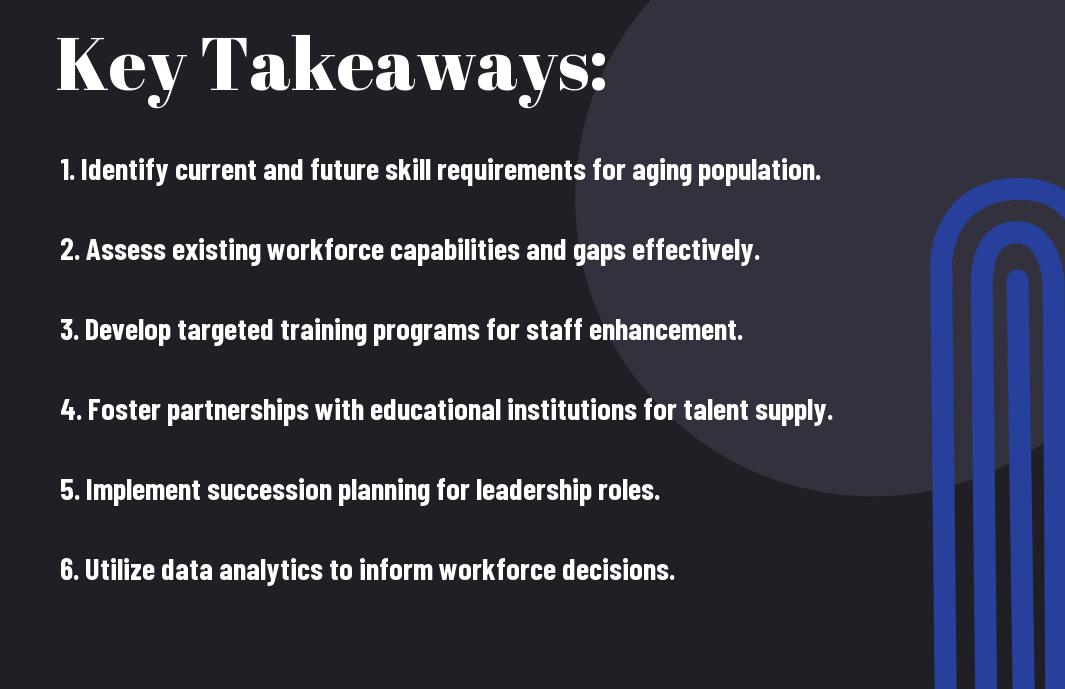SeniorCare organizations face significant challenges in ensuring an adequate workforce equipped with the necessary skills to provide exceptional care. As you navigate this landscape, it’s imperative to identify and address skill gaps that can hinder service quality. Implementing a strategic workforce planning approach allows you to align your team’s skills with the evolving needs of senior care, ultimately enhancing patient outcomes and satisfaction. By proactively addressing these gaps, you can foster a more resilient workforce that meets the demands of today’s complex healthcare environment.
Key Takeaways:
- Identifying skill gaps within the workforce is vital for enhancing the quality of care in senior services, leading to improved patient outcomes and staff satisfaction.
- Continuous training and development programs should be implemented to equip staff with the necessary skills and knowledge to meet evolving care demands.
- Collaboration with educational institutions can help in developing a pipeline of qualified professionals, ensuring that the senior care sector remains adequately staffed with skilled individuals.
Understanding the Importance of Strategic Workforce Planning
While the landscape of senior care services continues to evolve, effective strategic workforce planning is imperative in addressing urgent skill gaps. By anticipating future demands, you can align your staffing strategies with the needs of the community you serve, ensuring that quality care remains a top priority. This proactive approach enhances not only service delivery but also employee satisfaction and retention.
Overview of Senior Care Services
Strategic workforce planning in senior care services involves assessing the current staff’s skills, identifying future needs, and ensuring that your workforce is equipped to deliver high-quality support. With an aging population, the demand for personalized and compassionate care continues to grow, making it vital for providers to be adequately prepared.
The Role of Skill Gaps in Workforce Effectiveness
For your organization to thrive in senior care, it’s important to recognize how skill gaps can hinder workforce effectiveness. Identifying and addressing these gaps not only enhances service delivery but also boosts overall morale and reduces employee turnover.
Also, acknowledging the presence of skill gaps can have significant implications for your organization. Without targeted training and recruitment efforts, you may face increased employee dissatisfaction, elevated turnover rates, and ultimately a decline in the quality of care provided. By proactively seeking to fill these gaps, you can foster a more competent workforce, leading to improved patient outcomes and a more sustainable care environment for seniors. This alignment with community needs not only supports your staff but also strengthens your organization’s reputation.
Identifying Current and Future Skill Gaps
The identification of current and future skill gaps in senior care services requires a thorough understanding of both existing capabilities and anticipated needs. By evaluating your workforce’s competencies, you can pinpoint areas that require enhancement or development. This proactive approach allows you to align your strategic workforce planning with the evolving demands of the industry, ensuring that your team is equipped to deliver quality care to the senior population both today and tomorrow.
Assessment Techniques
The assessment techniques you choose to implement play a vital role in identifying skill gaps within your team. Utilizing methods such as competency evaluations, performance reviews, and employee self-assessments will provide you with valuable insights into the strengths and weaknesses of your workforce. These diagnostic tools enable you to create targeted training programs, ensuring that your personnel can meet the specific needs of the senior care sector.
Analyzing Industry Trends
Behind your workforce planning, it’s necessary to analyze industry trends that influence the senior care sector. Keeping abreast of these trends helps you anticipate emerging skill requirements and adapt your staffing strategies accordingly.
Assessment of industry trends reveals potential challenges your organization may face, such as shifting regulatory landscapes, technological advancements, and changing demographics among seniors. By being aware of these factors, you can proactively address the skills your workforce will need in the future. For instance, an increasing reliance on telehealth services may necessitate new training in digital communication and technology use. Understanding these trends allows you to develop a forward-thinking workforce strategy that not only fills current gaps but also prepares your team for future demands in senior care services.
Developing a Skilled Workforce
Not having a skilled workforce can significantly hinder the quality of care provided in senior services. To ensure high standards and meet the growing needs of the aging population, you must prioritize the development of a comprehensive workforce that is well-equipped with the necessary skills and knowledge. By focusing on effective training, professional development, and solid recruitment strategies, you can build a team that enhances the overall effectiveness of your organization.
Training and Development Programs
Development programs are vital for enhancing the skills of your staff in senior care services. These programs provide ongoing education and hands-on training in areas such as patient care, communication, and emergency response, shaping your workforce into competent and confident caregivers. By offering these opportunities, you not only boost employee morale but also improve retention rates, ensuring a stable and reliable team dedicated to quality service.
Recruitment Strategies for Senior Care Services
Developing effective recruitment strategies is vital for attracting qualified candidates to your senior care services. By utilizing diverse channels such as community outreach, partnerships with educational institutions, and targeted advertisements, you can reach a wider pool of potential employees. Offering internships and mentorship programs can also entice individuals to consider a career in senior care. Make your organization stand out by highlighting your commitment to employee development and a supportive work environment.
Even with solid recruitment strategies, you must keep in mind that the landscape of senior care is competitive. Focusing on outreach to local educational institutions can connect you with aspiring professionals. By creating a positive reputation within the community and showcasing your commitment to employee advancement, you can attract the right talent. Don’t underestimate the importance of an appealing work culture that highlights employee satisfaction and career growth opportunities, as these factors can set your organization apart in a saturated market.

Implementing Technology Solutions
To effectively address skill gaps in senior care services, you must consider implementing technology solutions that streamline operations and enhance staff capabilities. By integrating advanced tools, your organization can improve communication, training, and resource allocation, ultimately leading to better care outcomes for residents. Embracing innovation not only aids your workforce in meeting the complexities of senior care, but it also positions your organization as a forward-thinking leader in the industry.
Digital Tools for Workforce Management
One way to manage your workforce more effectively is by utilizing digital tools tailored for workforce management. These platforms allow you to schedule staff efficiently, track attendance, and assess performance metrics in real time. By automating administrative tasks, your team can focus more on personal interactions and care, thereby improving overall service delivery.
The Impact of Telehealth on Skill Requirements
Along with the rise of telehealth, your skill requirements will evolve to include not only traditional caregiving capabilities but also technological competencies. Telehealth solutions enable healthcare providers to consult with patients remotely, necessitating training in digital communication platforms. This innovation promotes accessibility, but it also demands that you and your staff acquire new skills related to virtual patient engagement and remote monitoring.
For instance, as telehealth becomes integral to patient care, you need to adapt to the integration of digital health records and remote monitoring technologies. Your staff must learn to use video conferencing tools to conduct virtual visits, which can lead to a gap if existing skills are not updated. Moreover, being proficient in telehealth technologies allows your employees to offer efficacious care and address concerns swiftly, increasing patient satisfaction. However, without appropriate training and resources, these advancements might exacerbate existing skill gaps rather than alleviate them.
Collaboration with Educational Institutions
All senior care services can greatly benefit from collaboration with educational institutions. By forging strong partnerships, you can ensure that the workforce is equipped with the necessary skills and expertise to meet the growing demands of the industry. This collaboration not only helps in talent acquisition, but it also enhances the overall quality of care provided to the elderly, ultimately leading to improved outcomes and satisfaction for both staff and residents.
Partnerships for Curriculum Development
The collaboration with educational institutions allows you to actively participate in curriculum development, ensuring that emerging healthcare trends and required skill sets are integrated into training programs. By contributing your insights, you can help shape a curriculum that prepares future caregivers to excel in their roles, ultimately bridging the skill gap present in senior care services.
Internship and Placement Opportunities
Internship opportunities serve as a bridge between educational institutions and the senior care sector, allowing students to gain valuable hands-on experience. These placements provide real-world exposure to the challenges and rewards of working in senior care, equipping future employees with the skills needed to deliver high-quality services. Furthermore, they foster a sense of commitment as students often convert their internships into permanent positions, helping you build a skilled and dedicated workforce.
This approach not only helps students gain practical experience but also enables you to assess potential hires in a real-world setting. By facilitating internship and placement opportunities, you mitigate the risk of hiring unsuitable candidates, while simultaneously creating a talent pipeline that meets your facility’s specific needs. Additionally, fostering a relationship with local educational institutions allows you to collaborate on designing training workshops that can be tailored to address current skill gaps in your organization, ultimately leading to better care for your residents.

Monitoring and Evaluating Workforce Strategies
Your organization can significantly enhance its effectiveness in senior care services through systematic monitoring and evaluation of your workforce strategies. By tracking progress against established benchmarks, you can quickly identify areas needing improvement and ensure that your workforce is well-equipped to meet the demands of care. This proactive approach allows you to make informed decisions that support both staff and resident satisfaction.
Key Performance Indicators (KPIs)
Among the most effective ways to assess the success of your workforce strategies are well-defined Key Performance Indicators (KPIs). These measurable values enable you to evaluate team productivity, staff retention rates, and the quality of care provided, helping you identify whether educational and training initiatives are successful in bridging skill gaps.
Continuous Improvement Processes
For your workforce strategies to remain effective, implementing continuous improvement processes is imperative. This ongoing approach allows you to refine training programs and adapt to industry changes without losing momentum.
Also, integrating a strong feedback loop within your organization encourages input from employees, which can lead to innovative solutions and enhanced service quality. By regularly analyzing performance data and actively seeking suggestions for improvement, you can cultivate a culture of excellence and accountability. This ensures that both staff and residents experience consistent, high-quality care, making your senior care service not only competitive but also a leader in the industry.

Summing up
Conclusively, addressing skill gaps in senior care services through strategic workforce planning is necessary for enhancing the quality of care you provide. By assessing your current workforce and anticipating future needs, you can ensure that your team possesses the necessary skills to meet evolving demands. Some proactive approaches may include targeted training programs and recruitment strategies. For further insights on this topic, explore How to Overcome Skill Gaps in Healthcare with Medical …. Empowering your workforce not only improves service delivery but also fosters a positive environment for both staff and residents.
Q: What is Strategic Workforce Planning in Senior Care Services?
A: Strategic Workforce Planning in Senior Care Services involves developing a comprehensive approach to ensure that the right number of qualified staff are available to meet the needs of seniors. This process includes assessing current workforce capabilities, forecasting future demands based on demographic trends, and identifying gaps in skills or staffing levels. By aligning workforce strategies with organizational goals, senior care facilities can enhance patient care, improve staff retention, and ensure compliance with industry regulations.
Q: How can organizations identify skill gaps within their workforce?
A: Organizations can identify skill gaps by conducting regular assessments of employee competencies through evaluations, surveys, and feedback mechanisms. This process can include analyzing performance metrics, engaging in one-on-one discussions with staff, and utilizing industry benchmarks to assess standards. Additionally, organizations can integrate training programs that align with identified gaps, thereby enhancing staff capabilities and ensuring that their skill sets evolve along with changing care demands.
Q: What strategies can organizations implement to address these skill gaps?
A: To address skill gaps, organizations can implement various strategies such as investing in targeted training and development programs, creating mentorship opportunities, and fostering a culture of continuous learning. Furthermore, utilizing technology to streamline training processes and providing access to online resources can enhance skill acquisition. Collaborations with educational institutions can also ensure a pipeline of well-trained individuals entering the senior care workforce, while adjusting recruitment practices to attract diverse talent with the necessary skills.







